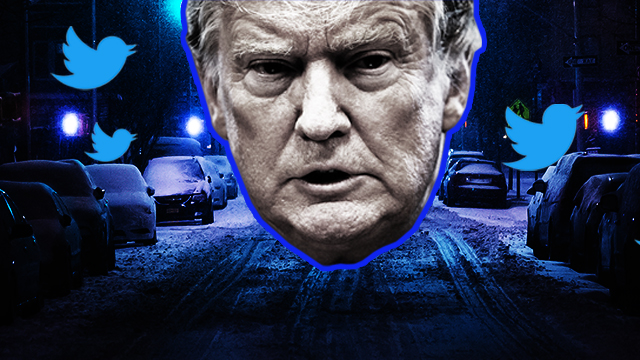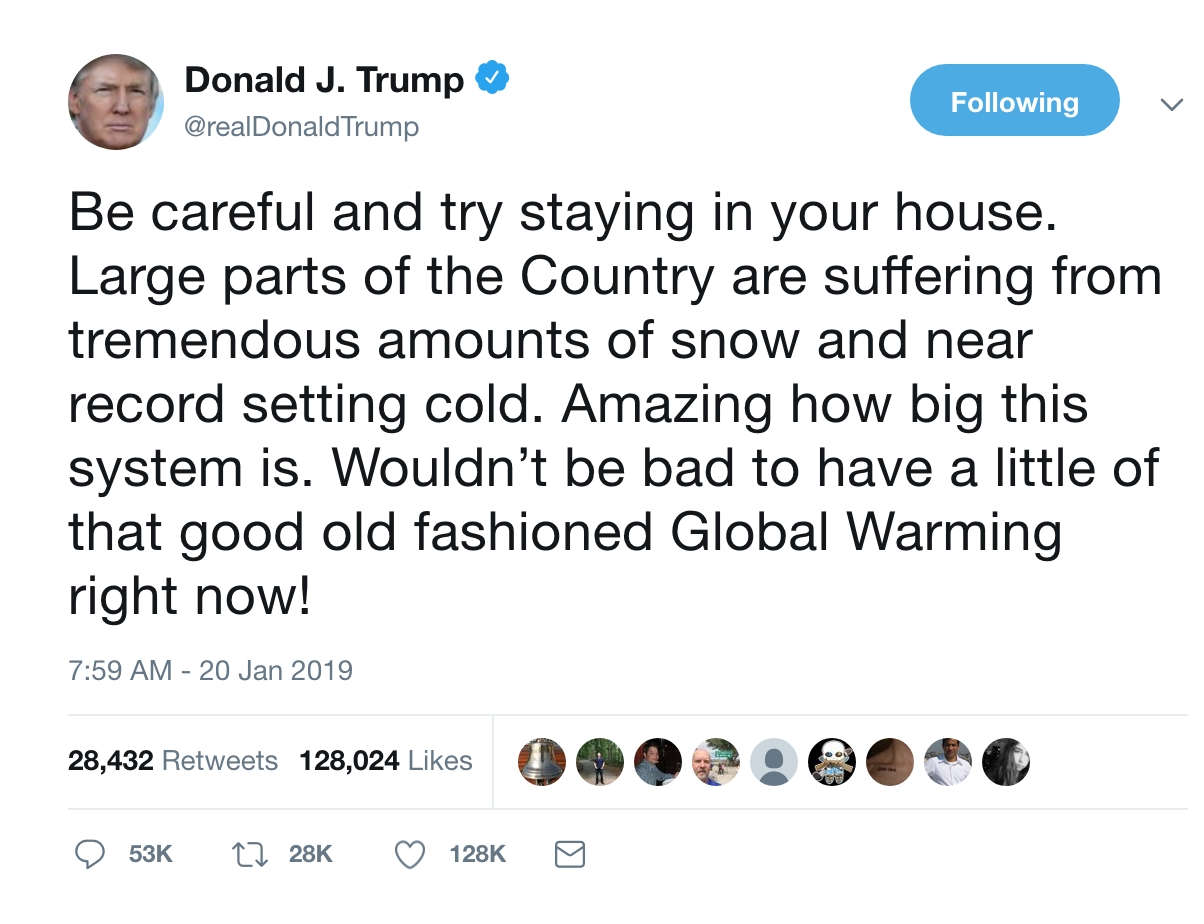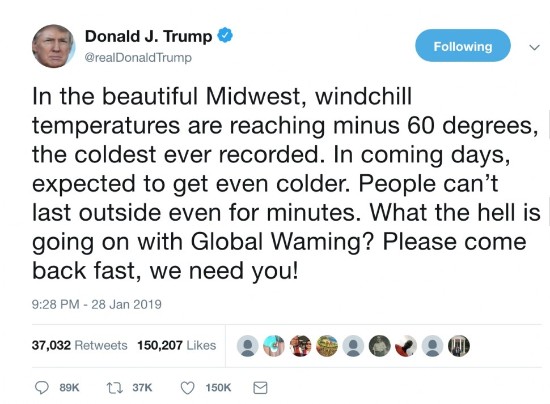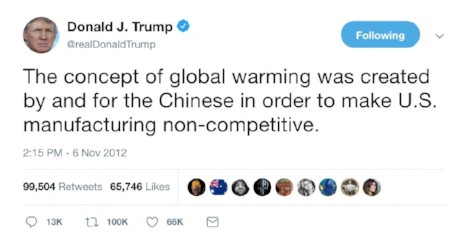
A polar vortex is hitting large swaths of the US this week, affecting around 200 million people. The brunt of the storm will hit the upper midwest; though up and down the east coast will see below-freezing temperatures, Chicago will reportedly be colder than Mt. Everest and parts of Antarctica, with lows hovering around -27 degrees Fahrenheit by the morning of Thursday, January 31.
For some—including the President of the United States—this extreme chill is a signal that climate change isn’t real. But he’s wrong. In fact, this arctic freeze supports claims that climate change is worsening. Here’s why.
First, what the President of the United States said.

On January 20, Trump tweeted, “Be careful and try staying in your house. Large parts of the Country are suffering from tremendous amounts of snow and near record setting cold. Amazing how big this system is. Wouldn’t be bad to have a little of that good old fashioned Global Warming right now!”
But one tweet, apparently, wasn’t enough.
He followed that up with another tweet on January 28, in which he stated, “In the beautiful Midwest, windchill temperatures are reaching minus 60 degrees, the coldest ever recorded. In coming days, expected to get even colder. People can’t last outside even for minutes. What the hell is going on with Global Waming[sic]? Please come back fast, we need you!”

These tweets seem wink-wink-nudge-nudge-y to fellow deniers, but any attempt at humor is clumsy at best (Trump has never been intentionally funny). After all, people die in weather events like this. In fact, according to the Chicago Tribune, there were 26 cold-related deaths in Cook County (where Chicago is located) in 2017 alone. And as this week’s storm is set to be a record-breaking event. People will, in all likelihood, die.
Trump has a habit of tweeting about climate change. A lot.

Trump has tweeted no fewer than 77 times about “global warming”, and 39 times about “climate change”—though the two often overlap, because he believes that the term “climate change” is now in use “because the first name didn’t work.” (This tally does not account for the myriad misspellings and typos, such as the recent “global waming” tweet.)
These tweets all have one thing in common: disbelief. Trump frequently refers to climate change as a hoax, and in 2012, he tweeted that it was a Chinese hoax, a plot to overtake the US in the global economy.
So it’s not exactly a surprise that he believes that this week’s record-breaking cold is proof that climate change is a farce.
His recent assertions about the cold weather are measurably wrong.
Global waming aside, Trump’s tweets are poor attempts at making light of a situation that he plainly doesn’t understand. The consensus in the scientific community is that, first and foremost, we shouldn’t conflate weather and climate, and the warming of the earth is not going to stop us from having winter. That said, climate change is actually causing extreme weather events, such as the polar vortex we’re experiencing this week.
The National Oceanic and Atmospheric Administration’s National Centers for Environmental Information, NASA, the United Nations, the Intergovernmental Panel on Climate Change, and even Vinny from The Jersey Shore all agree that climate change is the chief cause of an increase in extreme weather events.
So, how does climate change lead to extreme winter storms?
First, a note on what climate change actually is, because Trump seems to believe it’s a re-branded version of global warming. Where global warming is, well, the long-term warming of the planet (due, in large part, to the use of fossil fuels, which releases CO2 and other greenhouse gases, which trap heat), climate change is, according to NASA, the overall phenomena caused by the warming of the planet.
These phenomena “include the increased temperature trends described by global warming, but also encompass changes such as sea level rise; ice mass loss in Greenland, Antarctica, the Arctic and mountain glaciers worldwide; shifts in flower/plant blooming; and extreme weather events.”
So, in other words: global warming is a part of the larger problem of climate change, just one symptom of human intervention.
Now, onto why the existence of man-made climate change is not disputed by this week’s storm.
Winter storms don't prove that global warming isn't happening. https://t.co/LDqfq4JH9n pic.twitter.com/ndmLD637Cb
— NOAA Climate.gov (@NOAAClimate) January 29, 2019
First and foremost, the warming of the earth has made the atmosphere wetter, one of two key components of a winter storm (the other component being freezing air temperatures). Per the NOAA, the warming of the ocean has doubled in recent decades—about 1.4 degrees Fahrenheit. That has created an increase in water vapor on the ocean surface. Most importantly, according to the NOAA, “These storms draw much of their intensity from the extreme contrast between cold air over land and warmer, wetter air from over the ocean.”
(This is the same reasoning given for why hurricanes have been getting bigger and more destructive—warmer oceans and more vapor give these storm systems more to work with.)
The Climate Reality Project takes this one step further, and addresses why the midwest in particular—specifically, the area around the Great Lakes—has experienced (and will likely continue to experience) harsher winter events (such as more snowfall) as climate change worsens:
The collision of cold Arctic air with relatively warm unfrozen lake water in early winter that causes lake effect snows in the first place. The warmer those lake temperatures, the more moisture in the air, and the greater potential for lake effect snows.
So as the Great Lakes have warmed, snow events have increased overall.
There is also ample evidence that shows that, while we experience extreme winter events, the overall temperatures we experience are slowly warming. In fact, winters are warming faster than summers, according to the latest research—a pattern which will have far-reaching, devastating consequences.
What does that mean for us?
Per NASA, this means more negative changes over the next century: “More winter and spring precipitation is projected for the northern United States, and less for the Southwest, over this century.” Further, hurricanes will become stronger, ice caps and glaciers will continue to melt (possibly leading to an ice-free arctic), there will be more droughts and heat waves, and sweeping changes to precipitation patterns.
Vox also reports that we can expect an increase in pests, including ticks that cause lyme disease, and bark beetles, which “have devastated forests” across the US as the temperature has risen. Pollen will be produced earlier. Decreased snowpack will lead to floods in spring and droughts in summer.
We could go on, but it’s all getting a little doom-and-gloomy. The fact of the matter is that, while the earth is warming, we can still expect, you know, winter, but a more extreme version that, right now, is contributing to storms like this week’s polar vortex. And as long as we have politicians like Trump (and a hell of a lot of the GOP) making decisions, we aren’t likely to curb the damage we’ve already done, to say nothing of the devastation that is heading our way.
Tackling climate change will take individual changes, such as eating less meat and relying less on fossil fuels. But most importantly, it’ll take rapid systemic change the likes of which we have not seen before. That doesn’t happen when the president thinks it’s all a joke.
